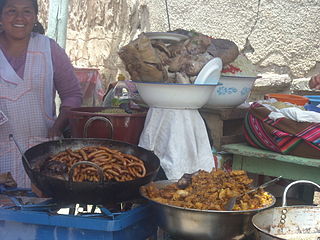 W
WThis is a list of African cuisines. A cuisine is a characteristic style of cooking practices and traditions, often associated with a specific culture. The various cuisines of Africa use a combination of locally available fruits, cereal grains and vegetables, as well as milk and meat products. In some parts of the continent, the traditional diet features a preponderance of milk, curd and whey products. The continent's diverse demographic makeup is reflected in the many different eating and drinking habits, dishes, and preparation techniques of its manifold populations.
 W
WThe cuisine of the Americas is made up of a variety of food preparation styles.
 W
WThis is a list of cuisines of the Americas. A cuisine is a characteristic style of cooking practices and traditions, often associated with a specific culture. The cuisines found across North and South America are based on the cuisines of the countries from which the immigrant peoples came, primarily Europe. However, traditional European cuisine has been adapted with the addition of local ingredients, and many techniques have been added to the tradition as well.
 W
WThis is a list of Asian cuisines, by region. A cuisine is a characteristic style of cooking practices and traditions, usually associated with a specific culture or region. Asia, being the largest, most populous and culturally diverse continent, has a great diversity of cuisines associated with its different regions.
 W
WThe Eurasian cuisine is a 'fusion' cuisine, mainly existing still in Singapore and Malaysia.
 W
WEuropean cuisine comprises the cuisines of Europe including the cuisines brought to other countries by European settlers and colonists. Sometimes the term "European", or more specifically "continental" cuisine, is used to refer more strictly to the cuisine of the western parts of mainland Europe.
 W
WThis is a list of European cuisines. A cuisine is a characteristic style of cooking practices and traditions, often associated with a specific culture. European cuisine refers collectively to the cuisines of Europe and other Western countries. European cuisine includes cuisines of Europe, including that of Russia, as well as non-indigenous cuisines of North America, Australasia, Oceania, and Latin America, which derive substantial influence from European settlers in those regions. The term is used by East Asians to contrast with Asian styles of cooking. This is analogous to Westerners referring collectively to the cuisines of Asian countries as Asian cuisine. When used by Westerners, the term may refer more specifically to cuisine in Europe; in this context, a synonym is Continental cuisine, especially in British English.
 W
WNorth American Cuisine includes foods native to or popular in countries of North America, such as Canadian cuisine, American cuisine, African American cuisine, Mexican cuisine and Central American cuisine. North American cuisines display influence from many international cuisines, including Native American cuisine, Jewish cuisine, African cuisine, Asian cuisine, and especially European cuisine.
 W
WThe cuisines of Oceania include those found on Australia, New Zealand, and New Guinea, and also cuisines from many other islands or island groups throughout Oceania.
 W
WSouth American cuisine has many influences, due to the ethnic fusion of South America. The most characteristic are Native American, African, Spanish, Italian, Portuguese, and Indian-South Asian. However, there is a mix of European, North American, and indigenous cuisines. The customs and food products greatly vary according to the physically distinct regions.
 W
WZambian cuisine is largely based on nshima, which is a food prepared from pounded white maize. Nshima is part of nearly every Zambian meal. In addition to nshima, Zambian cuisine includes various types of stew, cooked vegetables and different types of beer. Dried fish and insects are also eaten.